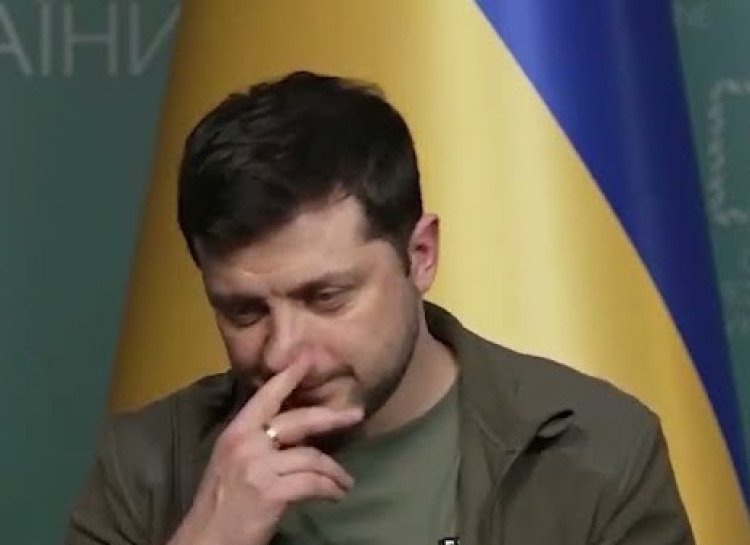
Shadow of Retaliation: Zelensky Relocated to Secret Bunker Amid Russian Strike Fears

In a startling turn of events that has sent ripples across global diplomatic circles, Ukrainian President Volodymyr Zelensky and his closest aides have reportedly been moved to heavily fortified underground bunkers as intelligence signals an imminent and potentially devastating Russian retaliation. The decision to retreat into secrecy comes amid escalating tensions following a daring Ukrainian strike deep inside Russian territory—an act that Moscow is now expected to answer with overwhelming force.
The move, cloaked in secrecy and executed under the tightest operational security, reflects the gravity of the current situation. While official statements remain vague, multiple sources close to Ukraine’s leadership confirm that the relocation was prompted by increasingly credible warnings of a “decisive and historic” Russian counteroffensive. Ukrainian officials are said to be bracing for a barrage that could target key government infrastructure, military command centers, and even symbolic sites within Kyiv itself.
The dramatic retreat to underground command posts evokes a wartime image that hasn’t been seen in Europe for decades. It signals not just concern, but fear—a raw, unfiltered sense of vulnerability that has now crept from Kyiv to the halls of power in Washington, London, Berlin, and beyond. Western leaders, while publicly reaffirming their support for Ukraine’s sovereignty and resilience, are reportedly rattled behind closed doors. The daring Ukrainian incursion inside Russian territory may have momentarily bolstered morale and demonstrated capability, but the cost of such audacity is beginning to take shape.
For the Kremlin, the incident appears to have crossed a line. Russian officials have used unusually forceful language in recent statements, warning of a response that will “resound through history.” Vladimir Putin, in a rare late-night address, described the Ukrainian strike as a “red line violation” and vowed consequences “not just equal, but disproportionate.” Analysts interpret this as a prelude to a multifaceted retaliation—military, cyber, and possibly even asymmetric tactics meant to destabilize Ukrainian society and its fragile wartime government.
The relocation of Zelensky has drawn criticism from Kremlin-linked media, with some commentators portraying the Ukrainian president as “the one who dared to strike but now hides like a rat.” The narrative is clearly being shaped to reinforce the idea that Ukraine’s leadership is both reckless and fearful—reckless in provocation, fearful in preparation for what may follow.
Despite the criticism, Ukrainian officials argue that the move is purely strategic. “This is not about fear,” one senior aide reportedly told an international journalist under the condition of anonymity. “This is about continuity of command. If the worst happens, we need to ensure leadership survives to carry on the fight.” Yet the optics of a head of state going underground are hard to ignore—and the psychological impact could reverberate among both allies and adversaries.
Across NATO capitals, there is increasing urgency to assess the potential fallout. Military planners are reviewing contingency protocols. Cybersecurity agencies are on high alert. Intelligence services are trying to distinguish bluster from battle plans. And in public, leaders are walking a tightrope: reassuring their citizens while avoiding escalation.
The Biden administration, when pressed by reporters, declined to confirm whether the U.S. had advance knowledge of Ukraine’s recent deep strike into Russian territory. However, a senior Pentagon official stated that “Ukraine has the right to defend itself, including through actions beyond its borders, when those actions target military capabilities that threaten Ukrainian lives.” This carefully worded statement illustrates the balancing act the West now finds itself in—supporting Ukraine’s defense while avoiding direct entanglement in a broader war.
In Europe, the reaction has been even more cautious. French President Emmanuel Macron and German Chancellor Olaf Scholz have both reiterated their calls for “strategic restraint” and a renewed push for diplomatic solutions. However, behind the scenes, there is growing concern that the conflict is entering a new and dangerous phase—one where lines between conventional warfare and state-sponsored terror may blur, and where escalation could become uncontrollable.
On the ground in Ukraine, citizens are experiencing a growing sense of unease. Air raid sirens are more frequent. Military checkpoints have been reinforced. Shelters are being stocked with supplies. And rumors of an impending large-scale missile barrage are spreading rapidly through social media and encrypted messaging apps. The government has urged the public to remain calm but vigilant, assuring them that “preparations have been made for every possible scenario.”
Still, for many Ukrainians, the sight—or absence—of their president, now operating from a hidden command center, is unsettling. Zelensky has become a symbol of resistance, a wartime leader whose daily addresses and appearances have bolstered morale. His sudden disappearance from the public eye, even if temporary, marks a shift in the tone of the conflict. It is no longer just about standing strong—it is about surviving the storm that may be coming.
What happens next is uncertain, but the stakes have never been higher. Russia, wounded and defiant, is preparing to strike back—not just with military might, but with the fury of a regime determined to reassert dominance. Ukraine, defiant but exposed, is digging in. And the world, watching with bated breath, is now forced to confront the very real possibility that the war may soon enter a chapter that historians will write about with both awe and dread.
For Zelensky, the bunker may offer safety, but it also symbolizes the precarious tightrope he now walks. He has dared to poke the bear. Now, as the world watches and waits, the question isn’t whether Russia will respond—but how far it will go when it does.


